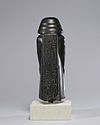Estatuilla de Padiiset
La estatuilla de Padiiset o estatuilla de Pateese,[1] también descrita como la estatua de un visir usurpada por Padiiset, es una estatuilla de basalto encontrada en 1894 en el Delta del Nilo que incluye una inscripción relativa al comercio entre Canaán y el Antiguo Egipto durante el tercer periodo intermedio.[2][3][4] La adquirió Henry Walters en 1928 y se expone actualmente en el Walters Art Museum.
| Estatuilla de Padiiset | ||
|---|---|---|
  Estatuilla de Padiiset en el Walters Art Museum, vista frontal y posterior | ||
| Material | Basalto | |
| Escritura | Jeroglíficos egipcios | |
| Realización | 1780-1700 a. C. (Inscripción: 900-850 a. C.) | |
| Descubrimiento | 1894 | |
| Ubicación actual | Walters Art Museum | |
| Identificación | 22203 | |
Se trata de la última referencia egipcia conocida a Canaán, más de 300 años posterior a la inscripción anterior conocida.[5] La inscripción también menciona Filistea (Peleset) como un lugar diferenciado, y se ha visto en esta mención una comprobación externa de que los filisteos todavía hablarían en esa fecha filisteo, una lengua diferenciada del resto de lenguas cananeas.[6]
La estatuilla está hecha de basalto negro y mide 30,5 x 10,25 x 11, cm. Se realizó en el reino medio para conmemorar el gobierno de un visir. Se cree que un milenio más tarde, la inscripción original se borró y se reemplazó con las inscripciones de la parte frontal y posteriores que representan a «Pa-di-iset, hijo de Apy» y honran a los dioses Osiris, Horus e Isis.[7]
Las inscripciones dicen:
Referencias
editar- ↑ Lemche, p.54
- ↑ Statue of a vizier usurped by Padiiset, at the Walters Art Museum
- ↑ The Statuette of an Egyptian Commissioner in Syria, Georg Steindorff, The Journal of Egyptian Archaeology, Vol. 25, No. 1 (Jun., 1939), pp. 30-33
- ↑ The Philistines in Transition: A History from Ca. 1000-730 B.C.E., Carl S. Ehrlich, p65
- ↑ Drews, 1998, p. 49a
In the Papyrus Harris, from the middle of the twelfth century, the late Ramesses III claims to have built for Amon a temple in ‘the Canaan’ of Djahi. More than three centuries later comes the next—and very last—Egyptian reference to ‘Canaan’ or ‘the Canaan’: a basalt statuette, usually assigned to the Twenty-Second Dynasty, is labeled, ‘Envoy of the Canaan and of Palestine, Pa-di-Eset, the son of Apy’.En el papiro Harris, de mitad del siglo XII, el difunto Ramsés III dice haber construido un templo a Amón en «la Canaán» de Djahi. Más de tres siglos más tarde viene la siguiente y última referencia egipcia a «Canaán» o «la Canaán»: una estatuilla de basalto, generalmente atribuida a la XII dinastía y etiquetada con «Enviado de la Canaán y Palestina, Pa-di-Eset, el hijo de Apy».
- ↑ Macalister, The Philistines: their history and civilization, p. 82
A basalt statuette of one Pet-auset was found somewhere in the Delta, in which he is described as an interpreter 'for Canaan and Philistia'. There would be no point in mentioning the two places if they had a common language. Ashdod, we have seen, preserved a patois down to the time of Nehemiah; but it is clear that the Philistines had become semitized by the time of the operations of the Assyrian kings.Se halló una estatuilla de basalto de un tal Pet-auset en algún lugar del Delta [del Nilo], en la que se le describe como intérprete «para Canaán y Filistea». No sería necesario mencionar ambos lugares si tuvieran un idioma común. Ashdod, como se ha visto, conservó un dialecto hasta los tiempos de Nehemías; pero es evidente que los filisteos se habían semitizado ya en la época de las operaciones de los reyes asirios.
- ↑ Helmut Brandl, Untersuchungen zur steinernen Privatplastik der Dritten Zwischenzeit: Typologie - Ikonographie -Stilistik, mbv-publishers, Berlin 2008, pp. 218-219, pls. 122, 180b, 186a (doc. U-1.1).
Bibliografía
editar- Editio princeps: Émile Gaston Chassinat, "Un interprète égyptien pour les pays cananéens". Bulletin de L'Institut Français d'Archéologie Orientale 1, 1901, 98
- Drews, Robert (1998), «Canaanites and Philistines», Journal for the Study of the Old Testament 81: 39–61.
- Macalister, Robert Alexander Stewart (1913). The Philistines: their history and civilization (en inglés). Londres: Published for the British Academy by H. Milford.